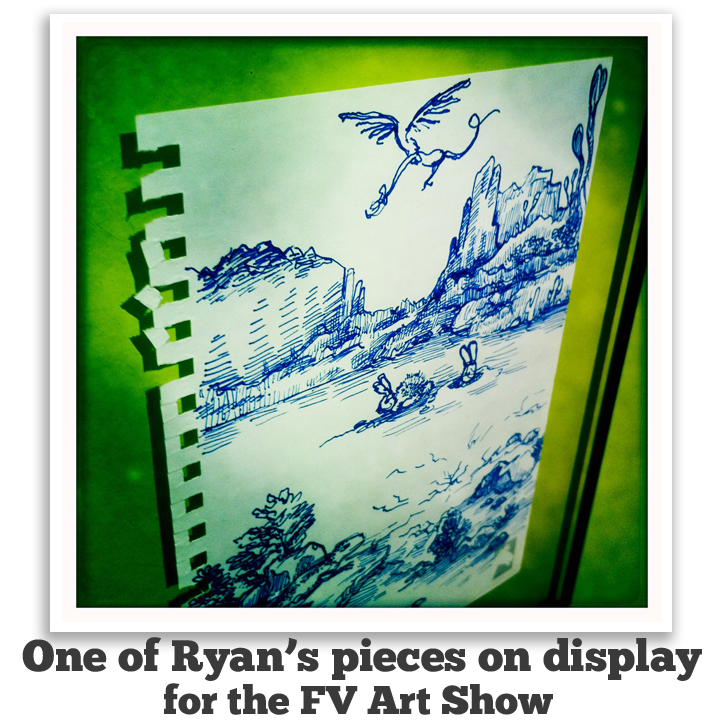We're kicking off June with a special spotlight on one of FableVision's talented developers, Ryan McNulty! FableVision is lucky to not only have a team of top notch artists, but we also boast a very skilled technical team. I sat down with Ryan this week to chat about his work as a FV Developer.
 FableVision gives you the opportunity to work on a variety of different projects, something that developers at other companies may not get to experience. What is your favorite type of project to do?
FableVision gives you the opportunity to work on a variety of different projects, something that developers at other companies may not get to experience. What is your favorite type of project to do?
Games. Definitely games. It’s an easy answer because games are fun to play, but they’re also the most rewarding to create. I think it’s because you really can’t tell how well a game is going to work until you start building it. There are always unforeseen situations and problems to solve, and it’s a chance to get creative and really influence a product.
We [developers] like to joke that you’ve done a good job when no one notices you – but it’s true – the best games take you to a place where you’re not paying any attention to mechanics or physics or whatever because everything behaves exactly as you’d expect. It’s a little ethereal, but it’s all about the experience – it’s best when you’re not thinking about it.
[Play one of Ryan's favorite FV produced games: Flying with Buddy on the Dinosaur Train Website]
You recently worked on the Big Screen Books project. Can you tell us a little about the project?
Big Screen Books is a fantastic new product we’ve just launched for the interactive whiteboard. At its heart it’s a simple storybook reader. The idea is for the teacher to read to the class just like they always have, but without needing to flip the book around after each page to show the illustrations.
There are lots of add-ons and activities. Kids can record themselves reading, and there’s a cool little “Pic k-a-Reader” feature to call on a student at random – their name gets displayed in a fun animation. There are some great teacher tools for weaving discussion questions and outside resources into the stories, and to create writing prompts.
k-a-Reader” feature to call on a student at random – their name gets displayed in a fun animation. There are some great teacher tools for weaving discussion questions and outside resources into the stories, and to create writing prompts.
Some neat stuff, really – but it all respects the book itself, which I really like. We tried not to lose sight of what’s important or let the stories get overshadowed by useless bells and whistles.
What was your role on Big Screen Books and what is the process like for a developer on a project of that scale?
I was the lead developer on Big Screen, which is another way of saying that I was the only developer. It’s not unusual for FableVision to have a single developer on a project, and it works great in most cases. You keep ownership, and working in someone else’s code can be a bit like crawling into their brain, which is kind of disconcerting.
Big Screen Books had a very organic process – more than other projects I’ve worked on. We’d have a general idea of what a screen or activity might be like, and someone would do a concept sketch or I’d do a mock-up and we’d just run from there. That kind of open process is great for creative thinking and some great material came out of it, but it can also be difficult to back-pedal if you get too far down a particular path before realizing that another one would work better.
Interactive whiteboards (IWBs) are growing in popularity as education tools. Does developing for IWBs have unique challenges?
For sure. Creating software for whiteboards requires a real shift in thinking. You’ve replaced the typical scenario of a single user controlling everything on screen, and opened it up to a group environment. How do you engage a room of kids, all at once?
Then there are some simple things that aren’t immediately apparent. What if the person using the white board is short, and can only touch the lower half of the screen? What does it mean to be holding a pen instead of a mouse? Is it still natural to drag and drop when the screen is a few feet across? All these questions provide an opportunity to create a new user experience, and to be innovative rather than leaning on old conventions.
Your interests and skills extend beyond your role as developer—you’re also an artist. You spend a lot of time doodling, and even showcased some of your drawings in the recent FableVision art show. Have you always been into both art and computers?
 Yes, but until recently those things had always been kept separate. In school, all the way through college, art and programming were always treated as separate and opposing disciplines, they were not to be mixed. This was especially true in college where the fields of study were approached with a very purist outlook. It was like no one had ever heard of Photoshop.
Yes, but until recently those things had always been kept separate. In school, all the way through college, art and programming were always treated as separate and opposing disciplines, they were not to be mixed. This was especially true in college where the fields of study were approached with a very purist outlook. It was like no one had ever heard of Photoshop.
I suppose the life-changing event was when a friend introduced me to Homestar Runner --my first introduction to Flash. I was a few years out of school, and it inspired me to begin taking classes at Santa Barbara City College. I entered with the idea of working in animation but quickly got swept into games. Finally, here was a natural medium that joined both art and programming.
The first game I worked on was an awesomely cheesy poker game called Heads Up Texas Hold’Em that focused on detecting player tells. The biggest challenge was getting the computer to make good choices about the cards it was holding. Without getting too technical, the A.I. figured out how strong its hand was by comparing it to all other possible hands. It’s kind of like the scene at the end of War Games, where the computer simulates all the possible outcomes of nuclear armageddon, but in this case, someone wins. Anyway, the game would be fortunate to be in the bargain bin today but at the time, it won us an award from SBCC and a free hat!
You also have an interest in non-digital games—board games and card games. Do you think these “low-tech” sorts of games are just as important and useful as flashy computer games in the education world? How do you feel about the constant drive to make everything digital these days?
There’s a fantastic cover illustration from The New Yorker with a picture of a space man sitting in the middle of all sorts of broken digital media; tablets, CDs, 8-tracks, you name it. And he’s reading a comic book and he’s smiling. It’s a great statement on the transitory nature of digital products, but I think the simpler message is just “pick your vehicle wisely”. In other words, don’t make something digital just because that’s hip or the buzz – choose that medium because it’s best for what you’re trying to do.
 While [digital] educational games have certainly found a place in the classroom, I think most educators are still more familiar and comfortable with physical pen-and-paper tools. You’ll see Mastermind or Connect Four all over the place because it’s easy to understand what those games teach – logic, creative thinking, problem solving. But more importantly, that’s all you need. Putting those games on an iPad doesn’t make them any better.
While [digital] educational games have certainly found a place in the classroom, I think most educators are still more familiar and comfortable with physical pen-and-paper tools. You’ll see Mastermind or Connect Four all over the place because it’s easy to understand what those games teach – logic, creative thinking, problem solving. But more importantly, that’s all you need. Putting those games on an iPad doesn’t make them any better.
Where digital media is powerful is in its power to engage, and the ability to track and assess students as they play. And that’s huge – but I’d don’t think it will ever replace standard hands on stuff – just think about how much you can do with a set of blocks.
You took part in a “Cardboard Game Jam” recently. Can you tell us a little more about what a game jam is and your experience?
Game Jam is essentially a bunch of geeks and game lovers getting together to create a game in a weekend. Typically the jams are digital, so you need programmers and a reasonable knowledge base, but this one was for paper (physical) games. It’s a great format because anyone can get involved. You can move quickly and there are fewer limitations.
My team made a board game called “Swamped”, which was a kind of a mobile maze game. Players try to get their playing-piece to the center of the board, and then back out to another player’s starting space, in a grab-the-treasure-and-run theme. There were three types of blocking pieces, and some simple rules for moving them, so the general strategy is to try and clear a path for yourself while slowing your opponents down.
The best part of the weekend was just the massive amount of creative energy getting thrown around. There’s no room to be timid with ideas or to mull-over mechanics. Everyone just kind of throws stuff out there, and sees what sticks. People were spontaneously creating mini-games at dinner that had nothing to do with what they were working on with their teams – it was fantastic. I’m definitely looking forward to doing it again.
Thank you, Ryan!
Hey, blog readers: Do you have any questions for our Artists, Developers, Producers? Let us know and we'll include them in our upcoming Spotlights!

